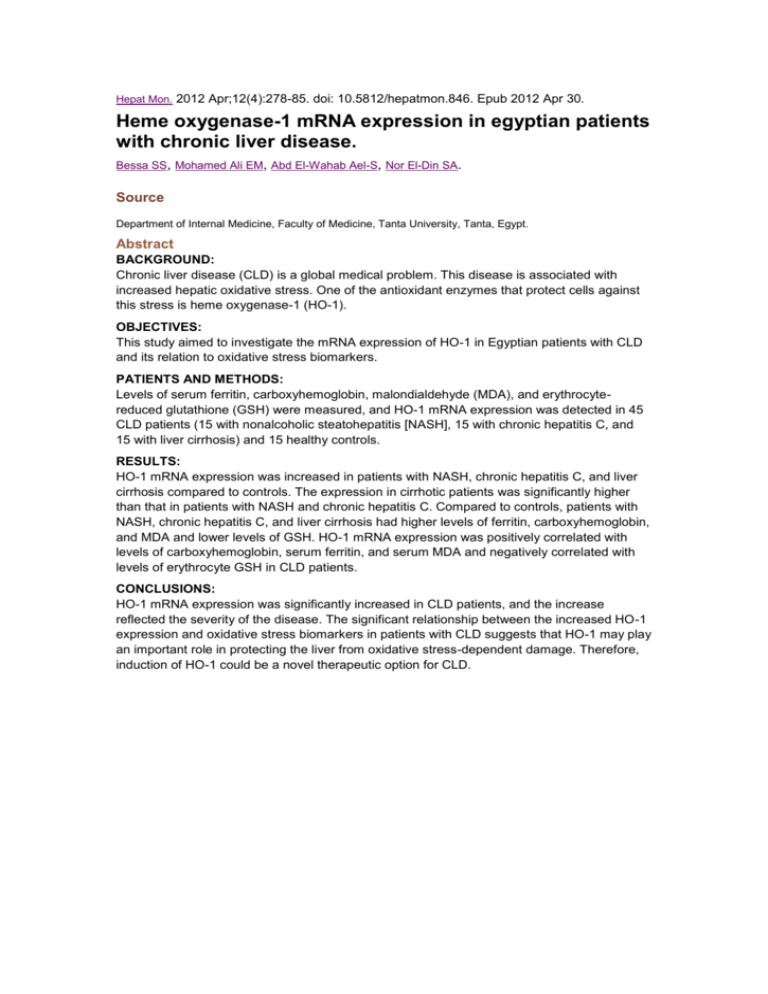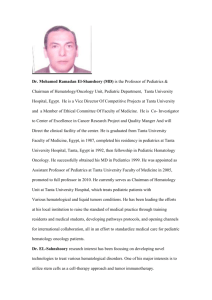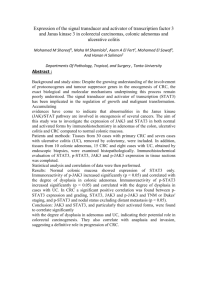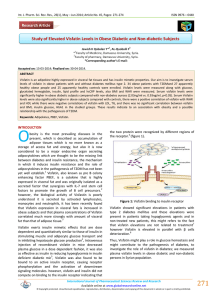
Hepat Mon. 2012 Apr;12(4):278-85. doi: 10.5812/hepatmon.846. Epub 2012 Apr 30.
Heme oxygenase-1 mRNA expression in egyptian patients
with chronic liver disease.
Bessa SS, Mohamed Ali EM, Abd El-Wahab Ael-S, Nor El-Din SA.
Source
Department of Internal Medicine, Faculty of Medicine, Tanta University, Tanta, Egypt.
Abstract
BACKGROUND:
Chronic liver disease (CLD) is a global medical problem. This disease is associated with
increased hepatic oxidative stress. One of the antioxidant enzymes that protect cells against
this stress is heme oxygenase-1 (HO-1).
OBJECTIVES:
This study aimed to investigate the mRNA expression of HO-1 in Egyptian patients with CLD
and its relation to oxidative stress biomarkers.
PATIENTS AND METHODS:
Levels of serum ferritin, carboxyhemoglobin, malondialdehyde (MDA), and erythrocytereduced glutathione (GSH) were measured, and HO-1 mRNA expression was detected in 45
CLD patients (15 with nonalcoholic steatohepatitis [NASH], 15 with chronic hepatitis C, and
15 with liver cirrhosis) and 15 healthy controls.
RESULTS:
HO-1 mRNA expression was increased in patients with NASH, chronic hepatitis C, and liver
cirrhosis compared to controls. The expression in cirrhotic patients was significantly higher
than that in patients with NASH and chronic hepatitis C. Compared to controls, patients with
NASH, chronic hepatitis C, and liver cirrhosis had higher levels of ferritin, carboxyhemoglobin,
and MDA and lower levels of GSH. HO-1 mRNA expression was positively correlated with
levels of carboxyhemoglobin, serum ferritin, and serum MDA and negatively correlated with
levels of erythrocyte GSH in CLD patients.
CONCLUSIONS:
HO-1 mRNA expression was significantly increased in CLD patients, and the increase
reflected the severity of the disease. The significant relationship between the increased HO-1
expression and oxidative stress biomarkers in patients with CLD suggests that HO-1 may play
an important role in protecting the liver from oxidative stress-dependent damage. Therefore,
induction of HO-1 could be a novel therapeutic option for CLD.
Ren Fail. 2012;34(6):670-5. doi: 10.3109/0886022X.2012.674438. Epub 2012 Apr 10.
Urinary platelet-derived growth factor-BB as an early
marker of nephropathy in patients with type 2 diabetes:
an Egyptian study.
Bessa SS, Hussein TA, Morad MA, Amer AM.
Source
Department of Internal Medicine, Faculty of Medicine, Tanta University, Tanta, Al-Gharbia, Egypt.
saharbessa@yahoo.com
Abstract
BACKGROUND:
Diabetic nephropathy (DN) is one of the most serious complications of diabetes worldwide.
Strong evidence suggests that several growth factors may contribute to the initiation and
progressive fibrosis of DN. Recently, there is an overexpression of platelet-derived growth
factor (PDGF) in renal biopsies from patients with DN. This study aimed to investigate the
clinical significance of urinary PDGF-BB level in type 2 diabetic patients with and without
nephropathy and to evaluate its relationship with various clinical and laboratory parameters.
METHODS:
Urinary levels of PDGF-BB were measured in 60 Egyptian type 2 diabetic patients
categorized into three equal groups (normo-, micro-, and macroalbuminuria), according to
urinary albumin level. In addition, 20 healthy subjects were selected to serve as controls.
RESULTS:
The urinary PDGF-BB levels were significantly increased in type 2 diabetic patients as
compared to controls (p < 0.001). Moreover, diabetics with micro- and macroalbuminuria had
significantly higher levels than in those with normoalbuminuria (p < 0.001). Urinary PDGF-BB
correlated positively with disease duration, low-density lipoprotein (LDL)-cholesterol, and
urinary albumin and negatively with creatinine clearance in diabetic patients. In a multiple
regression model, urinary PDGF-BB was strongly and independently associated with
nephropathy in diabetic patients (β = -0.03, p < 0.001).
CONCLUSIONS:
PDGF-BB may play an important role in the initiation and progression of DN. It is considered
as a good predictor for early deterioration of renal function in DN. Thus, measurement of
urinary PDGF-BB in type 2 diabetic patients could be used for early detection of diabetic renal
disease.
Int J Lab Hematol. 2012 Aug;34(4):369-76. doi: 10.1111/j.1751-553X.2012.01404.x. Epub 2012
Feb 9.
Role of DNA methyltransferase 3A mRNA expression in
Egyptian patients with idiopathic thrombocytopenic
purpura.
El-Shiekh EH, Bessa SS, Abdou SM, El-Refaey WA.
Source
Internal Medicine Department, Faculty of Medicine, Tanta University, Tanta, Egypt.
Abstract
INTRODUCTION: Idiopathic thrombocytopenic purpura (ITP) is an organ-specific
autoimmune hemorrhagic disease characterized by breakdown of self-tolerance and
triggering autoreactive lymphocytes' response against platelets. The underlying etiology of
ITP remains largely unknown. DNA methylation plays an essential role in maintaining T-cell
function, and impaired methylation can lead to inappropriate gene expression and contribute
to T-cell autoreactivity and autoimmunity. The aim of this study was to evaluate the role of
DNA methyltransferase 3A gene expression in the pathogenesis of ITP. METHODS: This
study included 60 subjects: 20 healthy volunteers as a control group, 20 patients with acute
ITP, and 20 patients with chronic ITP. DNA methyltransferase 3A (DNMT3A) mRNA
expression in peripheral blood mononuclear cells was measured by real-time quantitative
polymerase chain reaction. Plasma S-adenosylhomocysteine (SAH) levels were assayed with
reversed-phase high-performance liquid chromatography. Results: DNMT3A mRNA
expression was significantly decreased in patients with ITP as compared with that of the
control group. Plasma SAH level was significantly elevated in patients with ITP than in healthy
controls. However, no significant difference was found in DNMT3A mRNA expression or
plasma SAH level between patients with acute and chronic ITP. Conclusions: Aberrant DNA
methylation status reflected by decreased mRNA expression of DNMT3A and increased
plasma SAH level may play an important role in the pathogenesis of ITP, although the precise
underlying mechanisms still await further investigations, and extensive work in this field is
clearly needed to provide novel therapeutic targets for ITP.
Eur J Intern Med. 2010 Dec;21(6):530-5. doi: 10.1016/j.ejim.2010.09.011. Epub 2010 Oct 20.
Serum visfatin as a non-traditional biomarker of
endothelial dysfunction in chronic kidney disease: an
Egyptian study.
Bessa SS, Hamdy SM, El-Sheikh RG.
Source
Department of Internal Medicine, Faculty of Medicine, Tanta University, Al-Geish Street, 31527 Tanta, Egypt.
saharbessa@yahoo.com
Abstract
BACKGROUND:
Endothelial dysfunction (ED) is closely linked to cardiovascular disease and outcome in
patients with chronic kidney disease (CKD). Visfatin is an adipocytokine that recently
generated much interest; however, its role in CKD remains to be clarified. This study aimed to
assess visfatin in correlation with markers of ED and inflammation in Egyptian patients with
CKD.
METHODS:
The study included 40 non-diabetic, clinically stable CKD patients and 20 healthy volunteers.
Serum levels of visfatin, markers of ED (intercellular adhesion molecule-1 (ICAM-1) and
vascular cell adhesion molecule-1 (VCAM-1)) and markers of inflammation (interleukin-6 (IL6), and C-reactive protein (CRP)) were measured. Endothelial function was evaluated using
brachial artery flow-mediated dilatation (FMD).
RESULTS:
Serum visfatin, ICAM-1, VCAM-1, CRP, and IL-6 levels were significantly elevated and
FMD% was decreased in CKD patients as compared to controls. Visfatin correlated positively
with ICAM-1, VCAM-1, CRP, and IL-6 and negatively with FMD% in CKD patients. In a
multiple regression model, visfatin was strongly and independently associated with FMD
(Beta=-0.02, P<0.001) in CKD patients.
CONCLUSIONS:
Serum visfatin is strongly associated with endothelial adhesion molecules and FMD%,
suggesting that visfatin is an important promising biomarker for prediction of ED and future
cardiovascular risk in CKD patients. Moreover, the relationship between visfatin and IL-6
indicates that circulating visfatin may reflect the sub-clinical inflammatory status. Thus, visfatin
might be involved in the complex interactions between ED, inflammation, and atherosclerosis
and their major clinical consequences; however, further prospective studies are required to
prove this hypothesis.
Crown Copyright © 2010. Published by Elsevier B.V. All rights reserved.
Hepatol Res. 2010 May;40(5):486-93. doi: 10.1111/j.1872-034X.2010.00628.x. Epub 2010 Mar
30.
Portal vein thrombosis in Egyptian patients with liver
cirrhosis: Role of methylenetetrahydrofolate reductase
C677T gene mutation.
Gabr MA, Bessa SS, El-Zamarani EA.
Source
Department of Internal Medicine, Faculty of Medicine, Tanta University, Tanta, Egypt.
Abstract
Aim: The pathogenesis of non-malignant portal vein thrombosis (PVT) in cirrhotic patients is
not clearly defined. This case-control study aimed to investigate the role of
methylenetetrahydrofolate reductase (MTHFR) C677T gene mutation in the pathogenesis of
PVT in Egyptian cirrhotic patients. Methods: Plasma homocysteine was measured and
MTHFR C677T gene mutation was detected in 76 cirrhotic patients (21 with PVT, 55 without
PVT) and 20 healthy controls. Results: The frequency of CC genotype (wide type) in cirrhotic
patients with PVT was lower than controls and cirrhotics without PVT. However, the frequency
of TT genotype (homozygous mutation) was elevated in cirrhotic patients with PVT as
compared to controls and those without PVT. Cirrhotic patients with PVT had significantly
higher homocysteine than those without PVT. Cirrhotic patients with TT genotype are at a
significant risk for PVT (odds ratio = 7.7, 95% confidence interval, 1.50-42.81) when
compared with CC genotype. Moreover, subjects carrying TT genotype had a higher
homocysteine than those carrying CC genotype. Conclusions: The TT genotype of MTHFR is
associated with an increased risk of PVT in Egyptian cirrhotic patients.
Hyperhomocysteinemia could be considered as a relatively new risk factor for PVT in cirrhotic
patients and plasma homocysteine should be investigated particularly in patients with PVT of
unexplained etiology. The important clinical implication is that the readily available therapy of
folate, vitamin B6 and B12 supplementation may reduce homocysteine and prevent further
thrombotic complications in cirrhotic patients carrying the TT genotype.
Eur J Intern Med. 2009 Oct;20(6):625-30. doi: 10.1016/j.ejim.2009.06.003. Epub 2009 Jul 12.
The role of glutathione S- transferase M1 and T1 gene
polymorphisms and oxidative stress-related parameters
in Egyptian patients with essential hypertension.
Bessa SS, Ali EM, Hamdy SM.
Source
Internal Medicine Department, Faculty of Medicine, Tanta University, Tanta, Egypt.
Abstract
BACKGROUND:
Essential hypertension is a complex, multifactorial, polygenic disease in which the underlying
genetic components remain unknown. Glutathione S-transferase (GST) enzyme is involved in
detoxification of reactive oxygen species. This study aimed to investigate GSTM1 and GSTT1
gene polymorphisms in Egyptian essential hypertensive patients and their relationship with
oxidative stress-related parameters.
METHODS:
The study included 40 newly-diagnosed, untreated, essential hypertensive patients and 40
normotensive subjects. Plasma levels of malondialdehyde (MDA), and nitrate/nitrite and
erythrocyte reduced glutathione (GSH), activities of catalase (CAT), superoxide dismutase
(SOD), glutathione peroxidase (GSH-Px), and glutathione S-transferase (GST) were
measured. Genotyping for GSTM1 and GSTT1 was performed.
RESULTS:
The frequency of GSTM1+ve/GSTT1+ve in hypertensives (5%) was lower than in
normotensives (37.5%).The frequency of GSTM1-ve/GSTT1-ve was elevated in
hypertensives (35%) as compared to normotensives (7.5%). Plasma MDA was higher and
nitrate/nitrite was lower in hypertensives than in normotensives. Erythrocyte GSH, activities of
CAT, SOD, GSH-Px, and GST of hypertensives were lower than normotensives. Moreover,
GST activity was lower in subjects with GSTM1-ve/GSTT1-ve than in those with
GSTM1+ve/GSTT1+ve. In hypertensives, both systolic and diastolic blood pressures were
negatively correlated with activities of CAT, GSH-Px, and GST.
CONCLUSIONS:
GSTM1-ve/GSTT1-ve is a potential genetic factor to predict development of essential
hypertension and permit early therapeutic intervention. The significant association between
blood pressure and oxidative stress-related parameters indicates the pathogenic role of
oxidative stress in hypertension. Antioxidants could be useful in the management of essential
hypertension to prevent progressive deterioration and target organ damage however, further
studies involving long-term clinical trials may help to assess the efficacy of these therapeutic
agents.











